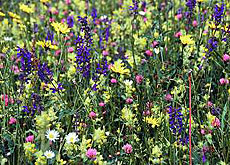Birds of prey protection accord takes wing

Experts from around the world, including Switzerland, have been attending a conference in Scotland aimed at saving rare birds of prey.
The meeting, the first of its kind, drew up the first steps towards an international agreement on protecting these migratory raptors – a move welcomed by Switzerland.
The four-day International Conference on the Protection of Africa-Eurasian migratory raptors, with representation from 44 countries, ended at Loch Lomond on Thursday.
Delegates discussed the best way to address key issues affecting birds of prey, including persecution, habitat destruction and the long-term effects of pollution.
They also addressed the geographical boundaries of the proposed agreement, the species to be covered and whether it should be legally binding. The accord is expected to be finalised in the United Arab Emirates next year.
At least 32 of the 60 migratory raptor species are rare or endangered in Europe, Asia and Africa. These include eagles, falcons, harriers, kites, buzzards and ospreys.
Switzerland’s central location in Europe meant many species of migratory birds that need protection pass through the country. These include raptors such as the red kite, the honey buzzard and the Scops owl.
Swiss interest
The Swiss delegation was headed by Olivier Biber from the species management department of the Federal Environment Office.
“Switzerland has a great interest in the conservation and wise management of the population of birds of prey,” Biber told swissinfo.
“Many birds pass through Switzerland and it has its own breeding populations that are partly composed of migratory birds that go to the Mediterranean and African region.”
Biber said the situation in Switzerland was good compared with many other countries – “we have a good legal system, all birds of prey and owls are protected” – but he admitted there were some areas where Switzerland could do better.
“We have land use problems and we have powerlines, which are the source of accidents for many birds of prey. It is of course a matter of finances.”
Biber said he was “happy” with the result of the meeting, which he described as “surely a step in the right direction”.
“The meeting chose to go for a memorandum of understanding … that would not be as strongly legally binding as a convention but still morally and politically binding,” he said.
He added that the other aim was an action plan. “This was the more concrete and applicable objective of this meeting, which was also met. We now have a catalogue of actions that should be taken in order to conserve all these species in the best way possible.”
Next steps
The event was taking place under the Convention on Migratory Species (CMS), a United Nations-sponsored treaty to protect endangered migratory birds and animals. The CMS, which has 101 signatories worldwide, has been in force in Switzerland since 1995.
The CMS says the decline in numbers of migratory birds of prey is mostly the result of human-induced threats, such as habitat loss and degradation as well as electrocution by power lines and shooting for sport. Climate change is also expected to be a threat.
Experts say that migratory raptors are particularly vulnerable because they have low rates of reproduction. They are considered to play a key role in the eco-system and are seen as sensitive indicators of changes to the environment.
Biber said the next step should be the elaboration of a financial plan. “Switzerland is very interested that the finances of such an instrument be as lean as possible. Even being a rich country we don’t have a lot of money to put into such instruments. So we want an instrument that is operative but not too expensive.”
He added: “There is still some way to go, but people were very enthusiastic and I’m quite confident that we’ll progress quite quickly in this direction.”
swissinfo
According to the CMS, at least 32 of the 60 migratory raptor species are rare or endangered in Europe, Asia and Africa. The figure could be higher given the lack of data from Africa and Asia.
The most serious threat faced by these birds is human-induced habitat loss and degradation. Climate change is expected to exacerbate these problems. Accidental mortality, such as collisions with aerial structures, electrocution and poisoning and shooting for sport, are also risk factors.
Raptors are long-lived species with low rates of reproduction. They play a key role in balancing the eco-system.
CMS is an intergovernmental treaty under the United Nations Environment Programme (UNEP) to conserve migratory species throughout their range (countries in which they are found).
It calls on parties to protect the most endangered species by conserving or restoring their habitat, mitigating obstacles to migration and controlling other risk factors.
It also encourages the Range States of Appendix II species (unfavourable conservation status) to make subsidiary agreements for their conservation and management. These are open to all Range States, not just to CMS Parties. The proposed raptor instrument will be one such agreement.

In compliance with the JTI standards
More: SWI swissinfo.ch certified by the Journalism Trust Initiative










You can find an overview of ongoing debates with our journalists here . Please join us!
If you want to start a conversation about a topic raised in this article or want to report factual errors, email us at english@swissinfo.ch.